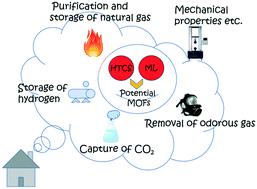当前位置:
X-MOL 学术
›
Mol. Syst. Des. Eng.
›
论文详情
Our official English website, www.x-mol.net, welcomes your
feedback! (Note: you will need to create a separate account there.)
Machine-learning-assisted high-throughput computational screening of high performance metal–organic frameworks
Molecular Systems Design & Engineering ( IF 3.2 ) Pub Date : 2020-03-25 , DOI: 10.1039/d0me00005a Zenan Shi 1, 2, 3, 4, 5 , Wenyuan Yang 1, 2, 3, 4, 5 , Xiaomei Deng 1, 2, 3, 4, 5 , Chengzhi Cai 1, 2, 3, 4, 5 , Yaling Yan 1, 2, 3, 4, 5 , Hong Liang 1, 2, 3, 4, 5 , Zili Liu 1, 2, 3, 4, 5 , Zhiwei Qiao 1, 2, 3, 4, 5
Molecular Systems Design & Engineering ( IF 3.2 ) Pub Date : 2020-03-25 , DOI: 10.1039/d0me00005a Zenan Shi 1, 2, 3, 4, 5 , Wenyuan Yang 1, 2, 3, 4, 5 , Xiaomei Deng 1, 2, 3, 4, 5 , Chengzhi Cai 1, 2, 3, 4, 5 , Yaling Yan 1, 2, 3, 4, 5 , Hong Liang 1, 2, 3, 4, 5 , Zili Liu 1, 2, 3, 4, 5 , Zhiwei Qiao 1, 2, 3, 4, 5
Affiliation

|
Over the past two decades, the number of works on metal–organic frameworks (MOFs) in the fields of gas adsorption and separation has experienced explosive growth due to their high void fraction and ultra-high specific surface area. With the rapid increase of MOF databases, high-throughput computational screening (HTCS) has become the main method for selecting high-performance target materials from the large quantity of MOFs. Traditional HTCS methods, e.g. grand canonical Monte Carlo (GCMC) and density functional theory (DFT), could accelerate the discovery of materials; however, there are some shortcomings in these methods such as high computational cost and slow speed, considering the vast and almost infinite MOF database as well as different separation systems and diverse operating conditions. Machine learning (ML) is a potential screening method with the ability to accurately predict the high-performance materials through the training of data, which were obtained by HTCS, and the ML model that fits accurately the complex system can improve the screening speed by 2–3 orders of magnitude. In this work, in view of ML-assisted HTCS of MOFs in recent years, the relevant research progress including CH4 storage, H2 storage, CO2 separation, etc. is summarized, aiming to clarify the potential problems and challenges about ML-assisted HTCS by categorizing the application and development of ML in this field. Then, a series of ML algorithms were designed and developed to adapt to different MOF systems, and to search key descriptors based on ML to reverse design new MOFs with excellent performance. Therefore, the ML-assisted HTCS method could accelerate the development of MOFs and promote their applications in various fields.
中文翻译:

机器学习辅助的高性能金属有机框架的高通量计算筛选
在过去的二十年中,由于气体空隙率高和比表面积超高,在气体吸附和分离领域中金属有机骨架(MOF)的研究工作经历了爆炸性增长。随着MOF数据库的迅速增加,高通量计算筛选(HTCS)已成为从大量MOF中选择高性能目标材料的主要方法。传统的HTCS方法,例如大经典的蒙特卡洛(GCMC)和密度泛函理论(DFT)可以加速材料的发现;但是,考虑到庞大且几乎无限的MOF数据库以及不同的分离系统和不同的操作条件,这些方法存在一些缺点,例如计算成本高,速度慢。机器学习(ML)是一种潜在的筛选方法,它能够通过训练通过HTCS获得的数据来准确预测高性能材料,并且精确适合复杂系统的ML模型可以将筛选速度提高2倍–3个数量级。在这项工作中,鉴于近年来MOS的ML辅助HTCS,相关的研究进展包括CH 4储存,H 2储存,CO归纳了2种分离方法等,旨在通过对ML在该领域的应用和发展进行分类,以阐明ML辅助HTCS的潜在问题和挑战。然后,设计并开发了一系列ML算法,以适应不同的MOF系统,并搜索基于ML的关键描述符,以反向设计性能优异的新MOF。因此,ML辅助HTCS方法可以加速MOF的发展,并促进其在各个领域的应用。
更新日期:2020-03-25
中文翻译:

机器学习辅助的高性能金属有机框架的高通量计算筛选
在过去的二十年中,由于气体空隙率高和比表面积超高,在气体吸附和分离领域中金属有机骨架(MOF)的研究工作经历了爆炸性增长。随着MOF数据库的迅速增加,高通量计算筛选(HTCS)已成为从大量MOF中选择高性能目标材料的主要方法。传统的HTCS方法,例如大经典的蒙特卡洛(GCMC)和密度泛函理论(DFT)可以加速材料的发现;但是,考虑到庞大且几乎无限的MOF数据库以及不同的分离系统和不同的操作条件,这些方法存在一些缺点,例如计算成本高,速度慢。机器学习(ML)是一种潜在的筛选方法,它能够通过训练通过HTCS获得的数据来准确预测高性能材料,并且精确适合复杂系统的ML模型可以将筛选速度提高2倍–3个数量级。在这项工作中,鉴于近年来MOS的ML辅助HTCS,相关的研究进展包括CH 4储存,H 2储存,CO归纳了2种分离方法等,旨在通过对ML在该领域的应用和发展进行分类,以阐明ML辅助HTCS的潜在问题和挑战。然后,设计并开发了一系列ML算法,以适应不同的MOF系统,并搜索基于ML的关键描述符,以反向设计性能优异的新MOF。因此,ML辅助HTCS方法可以加速MOF的发展,并促进其在各个领域的应用。










































 京公网安备 11010802027423号
京公网安备 11010802027423号